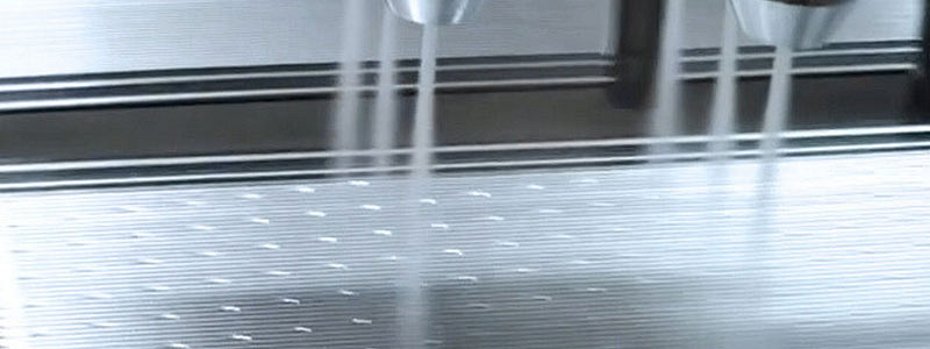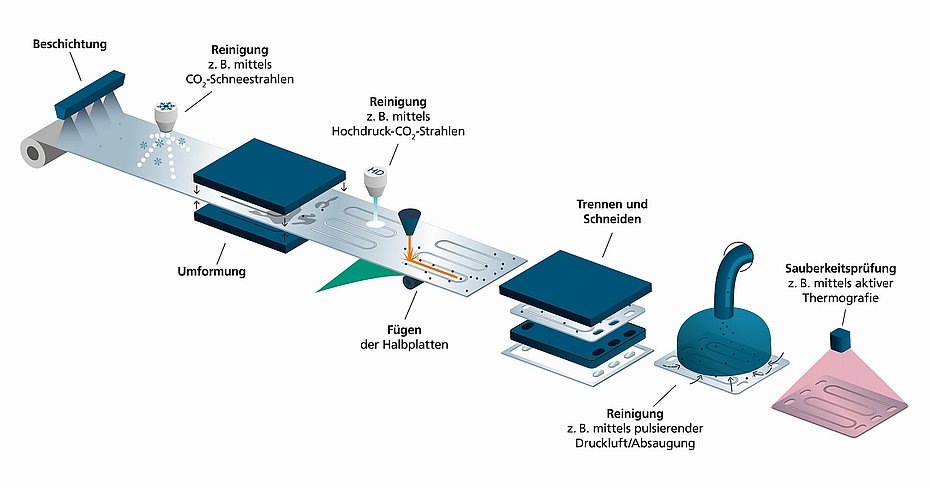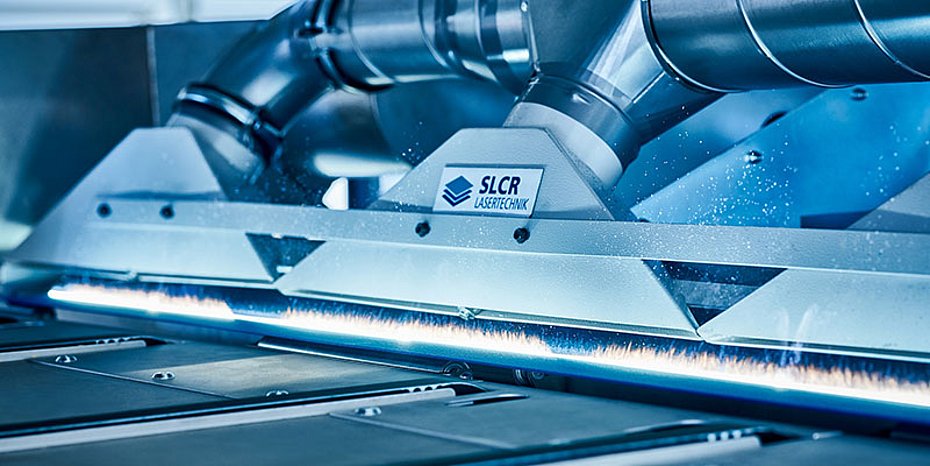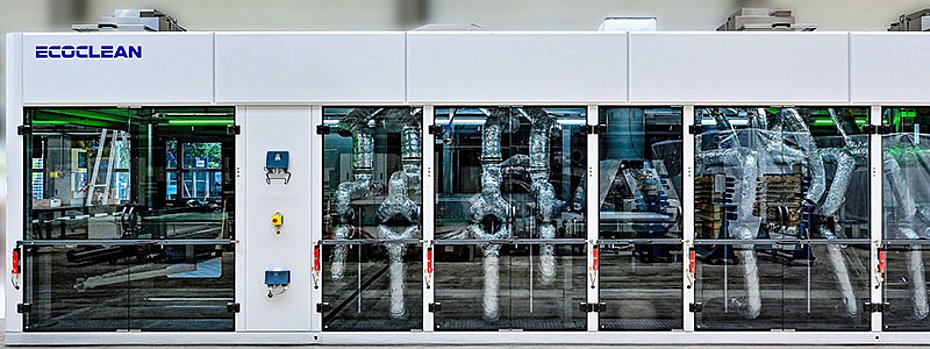Bipolar plates are core elements of fuel cell and electrolysis stacks. Their quality and efficiency have a decisive influence on the performance of the overall system. Contamination impairs the efficiency and service life of the plates, which makes cleaning a must. Efficient processes and systems for the sustainable, automated cleaning of plates are presented at parts2clean. The leading trade fair for industrial parts and surface cleaning will be held from October 7 to 9, 2025, parallel to Hy-Fcell at the Stuttgart Exhibition Center (Germany).
Whether as a central pillar for emission-free mobility or the energy transition, hydrogen technologies play a key role. As the heart of a fuel cell or electrolyser, bipolar plates connected in stacks are central elements. The plates consist of an anode and a cathode with a proton-conducting foil in between. They are made of different materials such as coated metal, graphite and graphite-polymer compounds. Metallic bipolar plates are considered advantageous in terms of low weight and volume as well as good cold-start capability. This variant also offers the potential for comparatively cost-efficient series production, which can be further improved through economies of scale.
Bipolar plates take care of gas, heat and electricity management
In stacks, bipolar plates physically and electrically connect the anode of one cell with the cathode of the neighboring cell. Using integrated flow profiles (flow fields), the plates not only regulate the supply of the reaction gases hydrogen on the anode side and oxygen on the cathode side, but are also responsible for the temperature control of the stacks, the release of water vapor as well as thermal and electrical energy. How efficiently they fulfill these multifunctional tasks determines the overall performance of a hydrogen system.
Cleanliness - crucial for quality and efficiency
The production of bipolar plates can be briefly summarized with the following steps: Unwinding the extremely thin and very sensitive raw material from a coil, forming it into anode and cathode plates, cutting and separating, coating and joining the plates. Apart from the fact that contamination such as rolling and drawing greases as well as unknown foreign substances from its production can already be present on the starting material, particulate and filmic contamination such as burrs, chips, fibers, dust, oils, emulsions, smoke and oxides are produced during each of the production steps. Any of these residues can later impair the quality of the bipolar plates, reduce their efficiency and service life or cause a defect. The requirements for cleanliness are therefore very high. To ensure this high level of component cleanliness, a cleaning process is essential before the joining and coating production steps. A major challenge here is the usually invisible, chemical-film residues on the surfaces, the composition of which is often unknown. In addition, bipolar plates are manufactured at high speed, which means that the required cleaning time is also an aspect that needs to be taken into account.
Adapted processes and cleaning solutions for bipolar plates
Various processes are available for cleaning. These include wet-chemical cleaning with solvents and water-based media, laser, steam and CO2 snow jet cleaning as well as plasma cleaning and hydro-cleaning. These methods are used individually or in combination, depending on the material, the contamination to be cleaned and the cleaning requirements. Wet chemical cleaning has established itself in many processes. Oils, greases and particles can be easily removed with solvents. With water-based media, the downstream drying required in many cases leads to high energy consumption and long cycle times.
Good results are achieved in very short times when cleaning off filmic-chemical and particulate contaminants, smoke and oxides with steam blasting. This is based on the interaction of steam with a proportion of liquid precisely matched to the cleaning task, a high-speed air flow and an adapted nozzle concept. Hydro-cleaning has also proven to be effective. The cleaning medium is applied to the surface using nozzles at defined pressures and temperatures. Dry CO2 snow jet cleaning with liquid carbon dioxide enables both the selective and full-surface removal of dirt and oxides as well as chemical-film contaminants and particles within very short cycle times. High-pressure (HP) CO2 blasting, in which liquid carbon dioxide at a pressure of up to 4000 bar is used as a blasting medium, also represents a promising solution.
In addition to various cleaning systems as chamber and immersion systems, Ecoclean offers the new EcoCvolta, a continuously operating system for cleaning bipolar plates. Tailored to specific requirements, this solution integrates various process options such as spraying, steam cleaning, hydro-cleaning, plasma cleaning, CO2 snow blasting and drying. The special design of the transport system ensures that the sensitive bipolar plates are handled gently.
The laser also uses thermal and photochemical effects to quickly and reliably remove contaminants such as oxides, smoke and particles as well as organic impurities. SLCR Lasertechnik has developed an innovative solution for fully automated surface structuring before coating and subsequent laser cleaning of bipolar plates. Targeted roughening of the surface with the laser in the first step can significantly improve the adhesion properties. The micro- and nanostructures created increase the specific surface area, which leads to better mechanical anchoring of the coating. The structuring can be adapted depending on the material and application in order to achieve the best possible wetting with the coating. In the automated solution, processing on both sides is a particular challenge, which is achieved by using a specially developed robot gripper. Laser cleaning takes place directly as a downstream second step, which reduces throughput times.
Specific information on processes at parts2clean
Exhibitors at parts2clean will provide information about these processes and systems as well as their advantages and limitations. The leading international trade fair for industrial parts and surface cleaning will be held from October 7 to 9, 2025, parallel to Hy-Fcell (October 7 to 8) at the Stuttgart Exhibition Centre (Germany). Visiting both trade fairs and the p2c.expert forum is possible with one ticket (OM-10/25).




